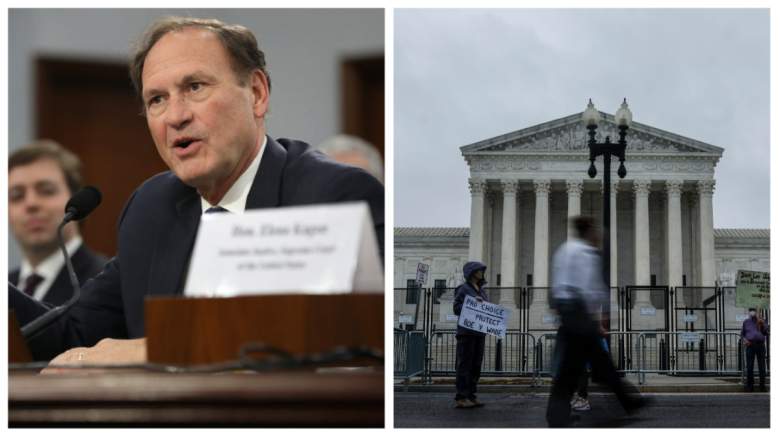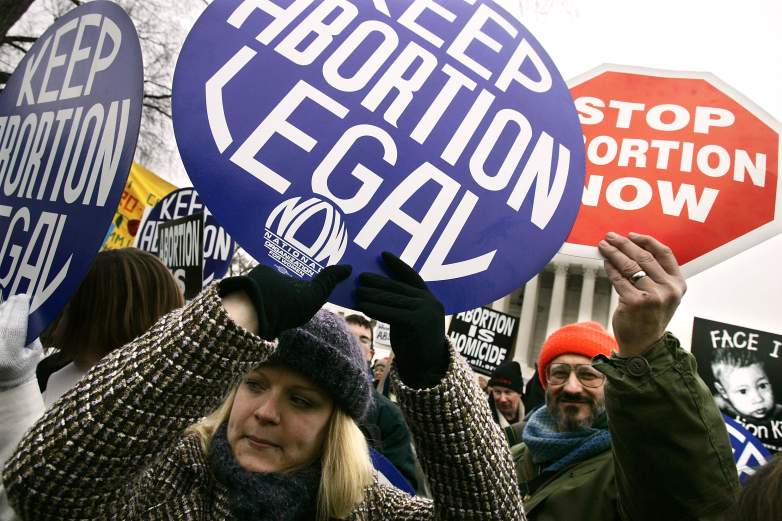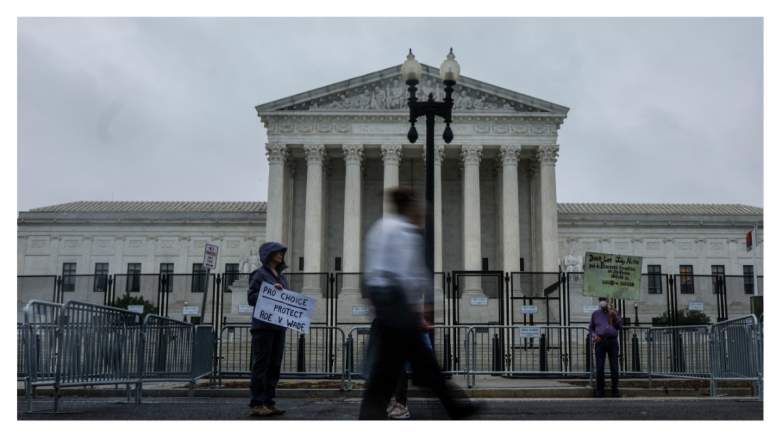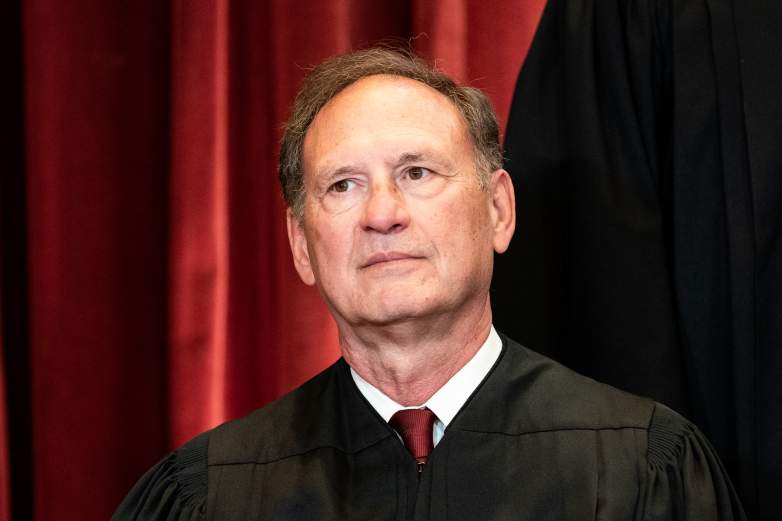
Getty Roe v. Wade was overturned.
The U.S. Supreme Court has overturned the landmark Roe v. Wade decision, writing that the right to an abortion is not protected by the U.S. Constitution.
The decision, which came down at 10:10 a.m. Eastern time on June 24, 2022, says, “The Constitution does not confer a right to abortion; Roe and Casey are overruled; and the authority to regulate abortion is returned to the people and their elected representatives.”
The court wrote, “Like the infamous decision in Plessy v. Ferguson, Roe was also egregiously wrong and on a collision course with the Constitution from the day it was decided.”
READ THE DECISION IN FULL HERE.
The dissenting justices wrote that “one result of today’s decision is certain: the curtailment of women’s rights, and of their status as free and equal citizens.”
The decision, authored by conservative Justice Samuel Alito, was widely expected and is hotly contested. The vote was 5-4 in favor of overturning Roe outright, with Chief Justice John Roberts not joining the majority on overturning Roe altogether but writing in a concurring opinion that he “would have only upheld Mississippi’s law banning abortions after 15 weeks,” CNN reported.
The case, one of the most important Supreme Court decisions in U.S. history, means that abortion restrictions will generally be left to the states to decide. In other words, the court’s decision does not mean that abortion will be banned in every state. It means that there is not a federal constitutional protection that stops states from banning abortion, according to SCOTUS.
U.S. Supreme Court opinions are posted in 10-minute intervals. The decisions for Friday, June 24, 2022, started posting at 10 a.m. At 10:10 a.m., Roe was overturned. It was the second decision of the day. The Roe v. Wade decision can be found here.
Here’s what you need to know:
1. The Court Found That the Constitution ‘Makes No Reference to Abortion’

GettyAnti-abortion rights activist Bill Rosanelli (right) of Montague, New Jersey, and local advocate for abortion rights Leanne Libert gathered outside the U.S. Supreme Court during a “March for Life” in January 2005.
The court’s decision finds no right to an abortion in the U.S. Constitution.
“We hold that Roe and Casey must be overruled. The Constitution makes no reference to abortion, and no such right is implicitly protected by any constitutional provision, including the one on which the defenders of Roe and Casey now chiefly rely — the Due Process Clause of the Fourteenth Amendment,” it reads.
The decision continues:
That provision has been held to guarantee some rights that are not mentioned in the Constitution, but any such right must be ‘deeply rooted in this Nation’s history and tradition’ and ‘implicit in the concept of ordered liberty.’ Washington v. Glucksberg, 521 U. S. 702, 721 (1997)
The right to abortion does not fall within this category. Until the latter part of the 20th century, such a right was entirely unknown in American law.
Indeed, when the Fourteenth Amendment was adopted, three quarters of the States made abortion a crime at all stages of pregnancy.
The abortion right is also critically different from any other right that this Court has held to fall within the Fourteenth Amendment’s protection of ‘liberty.’ Roe’s defenders characterize the abortion right as similar to the rights recognized in past decisions involving matters such as intimate sexual relations, contraception, and marriage, but abortion is fundamentally different, as both Roe and Casey acknowledged, because it destroys what those decisions called ‘fetal life’ and what the law now before us describes as an ‘unborn human being.’
Alito wrote, “The first 185 years after the adoption of the Constitution, each State was permitted to address this issue in accordance with the views of its citizens. Then, in 1973, this Court decided Roe v. Wade, 410 U. S. 113. Even though the Constitution makes no mention of abortion, the Court held that it confers a broad right to obtain one.”
2. The Court Ground Its Decision in American History

GettyNorma McCorvey, the woman at the center of the U.S. Supreme Court ruling on abortion, testifies before a U.S. Senate Judiciary Committee subcommittee in 1998, during hearings on the 25th anniversary of Roe v. Wade.
According to the Supreme Court decision, American history did not have a long tradition of legalizing abortion.
“Guided by the history and tradition that map the essential components of the Nation’s concept of ordered liberty, the Court finds the Fourteenth Amendment clearly does not protect the right to an abortion,” the decision reads.
“Until the latter part of the 20th century, there was no support in American law for a constitutional right to obtain an abortion. No state constitutional provision had recognized such a right. Until a few years before Roe, no federal or state court had recognized such a right. Nor had any scholarly treatise.”
Rather, wrote Alito, “Indeed, abortion had long been a crime in every single State. At common law, abortion was criminal in at least some stages of pregnancy and was regarded as unlawful and could have very serious consequences at all stages. American law followed the common law until a wave of statutory restrictions in the 1800s expanded criminal liability for abortions.”
Alito wrote: “By the time the Fourteenth Amendment was adopted, three-quarters of the States had made abortion a crime at any stage of pregnancy. This consensus endured until the day Roe was decided. Roe either ignored or misstated this history, and Casey declined to reconsider Roe’s faulty historical analysis.”
3. The Liberal Justices Warned of Ramifications of Overturning Roe in Their Dissent

GettyThe U.S. Supreme Court.
The liberal justices on the court wrote in a dissent that the majority had discarded a proper balance. They wrote that the court’s majority:
…says that from the very moment of fertilization, a woman has no rights to speak of. A State can force her to bring a pregnancy to term, even at the steepest personal and familial costs. An abortion restriction, the majority holds, is permissible whenever rational, the lowest level of scrutiny known to the law. And because, as the Court has often stated, protecting fetal life is rational, States will feel free to enact all manner of restrictions. The Mississippi law at issue here bars abortions after the 15th week of pregnancy. Under the majority’s ruling, though, another State’s law could do so after ten weeks, or five or three or one—or, again, from the moment of fertilization.
States have already passed such laws, in anticipation of today’s ruling. More will follow. Some States have enacted laws extending to all forms of abortion procedure, including taking medication in one’s own home. They have passed laws without any exceptions for when the woman is the victim of rape or incest. Under those laws, a woman will have to bear her rapist’s child or a young girl her father’s—no matter if doing so will destroy her life. So too, after today’s ruling, some States may compel women to carry to term a fetus with severe physical anomalies—for example, one afflicted with Tay-Sachs disease, sure to die within a few years of birth.
States may even argue that a prohibition on abortion need make no provision for protecting a woman from risk of death or physical harm. Across a vast array of circumstances, a State will be able to impose its moral choice on a woman and coerce her to give birth to a child.
Enforcement of all these draconian restrictions will also be left largely to the States’ devices.
Technically, the abortion case is called Dobbs v. Jackson Women’s Health Organization.
On June 22, SCOTUS blog wrote: “The Supreme Court has added another opinion day this week. The court will issue opinions on both Thursday and Friday at 10 a.m. EDT. There are 13 cases that still remain to be decided.” However, when the decisions came down on Thursday, they did not include Roe. That had all eyes turning to 10 a.m. Friday.
The justice who authored the opinion overturning Roe v. Wade, Samuel Alito, was nominated to the U.S. Supreme Court by former President George W. Bush, according to White House archives. He was confirmed to the court in 2006.
He was formerly an U.S. Attorney, a deputy assistant attorney general and a judge on the U.S. Court of Appeals.
4. A Draft Opinion Authored by Justice Alito Already Indicated the Court Was Poised to Strike Down Roe

GettyAssociate Justice Samuel Alito in April 2021.
The decision comes as no surprise because of the earlier leak of a draft opinion on the topic.
In May 2022, a leak from an unknown person to Politico revealed that a majority of the justices were poised to strike down Roe v. Wade.
The draft opinion was authored by Alito. It struck down the 1973 decision that found constitutional protection for abortion, as well as a 1992 decision upholding it, which is called Planned Parenthood vs. Casey.
“Roe was egregiously wrong from the start,” Alito wrote in the draft opinion. It’s always possible that the reasoning given in the draft opinion and the votes for or against striking down Roe v. Wade have changed since that time, of course. No one really knows that question for sure.
What is Dobbs? It’s a case from Mississippi in which Jackson Women’s Health Organization, which provides abortions, sued the state because it bans abortions after 15 weeks without exceptions for rape or incest. The case revolves around whether it’s unconstitutional for states to ban or restrict abortion before fetuses are viable or whether those decisions should be left to the states. In other words, the core question is whether abortion is protected by the U.S. Constitution.
5. Roe v. Wade Derived From a Texas Law Banning Abortion

GettyActivists on both sides of the abortion issue faced off in front of the U.S. Supreme Court in January 2006.
According to History.com, Roe v. Wade was issued on January 22, 1973. In it, the U.S. Supreme Court “struck down a Texas statute banning abortion, effectively legalizing the procedure across the United States.”
The court found a right to privacy in the Constitution’s 14th Amendment to justify its decision. Before Roe v. Wade, abortion was illegal “throughout much of the country since the late 19th century,” History.com reported.
However, states imposed restrictions on abortion that have also been litigated through the years.
Who was Jane Roe? She was Norma McCorvey, a Texas woman in her 20s, who wanted to have an abortion, according to History.com. She had given two children up for adoption.
In 2021, The Atlantic reported the name of McCorvey’s baby who was born before the Roe v. Wade decision came down: Shelley Lynn Thornton.
According to Reuters, McCorvey later came out against abortion but then revealed she was paid to do so.
READ NEXT: A Viral Video Shows a Cat Escaping a Coyote in Texas.